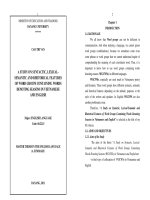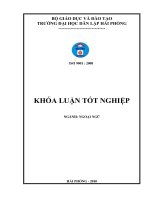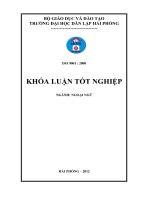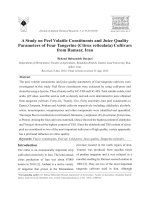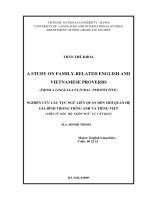A study on crate sizing, inventory and packing problem
Bạn đang xem bản rút gọn của tài liệu. Xem và tải ngay bản đầy đủ của tài liệu tại đây (1.37 MB, 149 trang )
A STUDY ON CRATE SIZING, INVENTORY AND
PACKING PROBLEM
LEE SHIH JIA
(B.Sc., Cornell)
(M.Sc., NUS)
A THESIS SUBMITTED
FOR THE DEGREE OF DOCTOR OF
PHILOSOPHY
DEPARTMENT OF INDUSTRIAL AND SYSTEMS
ENGINEERING
NATIONAL UNIVERSITY OF SINGAPORE
2014
DECLARATION
I hereby declare that this thesis is my original work and it has been written by me in its
entirety. I have duly acknowledged all the sources of information which have been used in
the thesis.
This thesis has also not been submitted for any degree in any university previously.
________________________
Lee Shih Jia
07 April 2015
i
Acknowledgements
This thesis is accomplished with tremendous help and guidance from both of
my supervisors, A/Prof Chew Ek Peng and A/Prof Lee Loo Hay who provided
relentless support and encouragement throughout the years.
To my family whom I could not spend more time with on many family
occasions, I could not express more gratitude for their kind understanding and
emotional support.
Lastly, we are also grateful to Company S Singapore Pte. Ltd. for the
inspiration and data provided for the study of this thesis.
ii
Table of Contents
Acknowledgements i
Table of Contents ii
Summary iv
List of Tables vi
List of Figures vii
List of Abbreviations ix
List of Notations x
1 Introduction and Overview 1
1.1 Background and Motivation 2
1.2 Organization of the Thesis 9
2 Literature Review 10
2.1 Crate Sizing Problem 10
2.2 Bin Packing Problem 14
3 Crate Length Optimization 24
3.1 Crate Length Optimization without Inventory Consideration 24
3.1.1 Modelling Assumptions 25
3.1.2 Problem Formulation 26
3.1.3 Computational Results 27
3.2 Crate Length Optimization with Inventory Cost Consideration 30
3.2.1 Modelling Assumptions 31
3.2.2 Problem Formulation 33
3.3 Dynamic Programming Approach 34
3.3.1 Dynamic Programming Formulation 36
3.3.2 Computational Results 38
4 Generalized Crate Sizing Problem 48
4.1 Modelling Assumptions 50
4.2 Problem Formulation 52
4.3 Enumeration Method 54
4.4 Marginal Improvement Method 55
4.4.1 Numerical Experiments 58
4.5 Genetic Algorithm Method 63
iii
4.5.1 Chromosome Representation 64
4.5.2 Creation of initial population 65
4.5.3 Selection Mechanism 65
4.5.4 Reproduction – crossover operation 66
4.5.5 Mutation Operator 70
4.5.6 GA Algorithm 71
4.5.7 Numerical Experiments 75
4.5.8 Determining the number of types 88
5 Bin packing (Rectangular) 89
5.1 Problem Description 93
5.2 Problem Formulation 96
5.3 (2D-BPP) Layer Packing 99
5.3.1 Layer Packing with Column Generation 99
5.3.2 Layer Packing with Improvement Heuristic 103
5.4 Multiple Height Packing 109
5.4.1 Problem formulation 110
5.5 Numerical Experiments 111
5.5.1 Comparison to MIP 111
5.5.2 Comparison to Maximal Rectangle Packing 111
5.5.3 Varying Demand Profile 112
6 Conclusions and Future Research 119
6.1 Conclusions 119
6.2 Future Research Topics 120
References 122
iv
Summary
This thesis is a formal study of an actual problem faced in the industry for
crate sizing, inventory and packing. The problem is relevant because many
manufacturers face the problem of proper planning, operations and evaluation
of their product packaging and packing processes. Since most products will
need to be packed before being distributed to customers, inefficient practices
will lead to higher cost and time expended. In this final process, many aspects
of the way the products are packed can be studied and improved. The
industrial crate sizing problem addresses the problem of determining what are
the optimal crate sizes and also how many types of crates are ideal. There is no
formal study to scientifically investigate the crate sizing problem yet.
Therefore, in this study, we first define and formalize the problem of crate
length optimization faced by the industry, and represent it as an MIP model.
The second problem is extended from the crate length optimization problem
which considers the inventory and we formulate it as a non-linear MIP model.
The tradeoff between inventory cost and wastage cost from fitting products
into crates is considered in the objective function. The non-linear MIP model
is generally difficult to solve, but by exploiting the structure of the problem,
we are able to solve it using dynamic programming because the problem has
the special property of Bellman’s Principle of Optimality. We further extend
the crate size optimization problem by considering the width and height
dimensions of the crate in addition to the length dimension. In this problem,
the products are in rolls; hence the crates are rectangular boxes with square
cross section which means the crate width and height are the same. The
problem is non-trivial and cannot be solved using any solvers for a reasonable
v
size problem. Enumeration method can only be used to solve small size
problems but is computationally intractable for larger problems. Therefore we
propose using a Hungarian based genetic algorithm to solve the problem.
Hungarian method is used to preserve the good neighbourhood structure which
is required for genetic algorithm to perform well. When the parents are
selected for crossover, it is treated as an assignment problem where the gene
of a parent is matched to the closest gene of another parent before applying the
crossover operations. In addition to the crate sizing and inventory problem,
this study also looks into the packing of the crates into containers. After
finding the crate size and crate types, we also need to pack the crates into
shipping containers for distribution. We solve the problem of packing crates
into containers by using a bin packing algorithm with an improvement
heuristic. This approach utilizes the information of the solutions from the
previous iteration to create good potential columns for the next iteration.
Overall, this study has covered several of the important aspects which can be
improved for a real industrial-based problem and also proposes different
methods to tackle and solve the crate sizing, inventory and packing problem.
vi
List of Tables
Table 4.1 Comparison between MI and enumeration method for two sizes 59
Table 4.2 Comparison between MIBS, MIBR and enumeration method for
three sizes 60
Table 4.3 Comparison between MIBS and enumeration method for four sizes
61
Table 4.4 Comparison between MIBR and enumeration method for four sizes
62
Table 4.5 Parameters of GA experiment I 78
Table 4.6 Comparison between GA and enumeration for two-size problem 79
Table 4.7 Comparison between GA and enumeration for three-size problem. 80
Table 4.8 Comparison of GA to enumeration and MIBS I, MIBS II and MIBR
for four-size problem 81
Table 4.9 Parameters of GA experiment II 83
Table 4.10 Parameters of GA experiment III 86
Table 5.1 Comparison to MIP 111
Table 5.2 Comparison of utilization before and after improvement 112
Table 5.3 Variance Level versus Packing Utilization Results I 113
Table 5.4 Crate size versus Packing Utilization Results II 113
Table 5.5 Variance Level versus Packing Utilization Results II 114
Table 5.6 Crate size versus Packing Utilization Results II 114
Table 5.7 Multiple height packing 115
Table 5.8 Packing of two types 116
Table 5.9 Packing of three types 117
Table 5.10 Packing of four types 118
vii
List of Figures
Figure 1.1 Survey on annual shipping and packaging costs in 2013 2
Figure 1.2 Product packing hierarchy 3
Figure 1.3 Product dimensions before and after rolling 4
Figure 1.4 Packaging of roll in crates 4
Figure 1.5 Packing of crates in shipping containers 5
Figure 3.1 Roll Width Demand Distribution 28
Figure 3.2 Objective Value with Number of Crate Types 29
Figure 3.3 Optimal Crate Lengths for Given Number of Crate Types 30
Figure 3.4 Optimal Number of Crate Types at Varying Values of h 39
Figure 3.5 Optimal Number of Crate Types at Varying Values of p 40
Figure 3.6 Uniform Pattern of Mean Demand of Roll Widths 41
Figure 3.7 Normal Pattern of Mean Demand of Roll Widths 41
Figure 3.8 Right Skewed Pattern of Mean Demand of Roll Widths 42
Figure 3.9 Total Cost vs Variance for a Uniform Pattern 43
Figure 3.10 Number of Optimal Types vs Variance for a Uniform Pattern 43
Figure 3.11 Total Cost vs Variance for a Normal Pattern 44
Figure 3.12 Number of Optimal Types vs Variance for a Normal Pattern 44
Figure 3.13 Total Cost vs Variance for a Right Skewed Pattern 45
Figure 3.14 Number of Optimal Types vs Variance for a Right Skewed Pattern
45
Figure 3.15 Total Cost at Different Levels of CV for a Uniform Demand 46
Figure 3.16 Total Cost at Different Levels of CV for a Normal Demand 47
Figure 3.17 Total Cost at Different Levels of CV for a Demand Pattern Similar
to Company S’s Actual Demand 47
viii
Figure 3.18 Total Cost at Different Levels of CV for a Demand Pattern Similar
to Company S’s Actual Demand 48
Figure 4.1 Pictorial representation of sizes and demand 54
Figure 4.2 Neighbours for marginal improvement 55
Figure 4.3 Directions for marginal improvement 56
Figure 4.4 Chromosome representation 65
Figure 4.5 A naïve crossover example 67
Figure 4.6 Naïve crossover example in a graph 68
Figure 4.7 Hungarian match crossover pairing 69
Figure 4.8 Hungarian match crossover pairing in a graph 69
Figure 4.9 Flowchart of GA algorithm 74
Figure 4.10 Convergence for a medium problem GA (5 sizes) 84
Figure 4.11 Convergence for a medium problem GA (10 sizes) 84
Figure 4.12 Convergence for a large problem GA 86
Figure 4.13 Objective value vs. increasing number of crate types 87
Figure 4.14 Objective value vs. increasing variance level 88
Figure 4.15 Objective value vs. Varying number of types 89
ix
List of Abbreviations
1D one-dimensional
2D two-dimensional
3D three-dimensional
BPP bin packing problem
CV coefficient of variance
GA genetic algorithm
IP integer programming
LP linear programming
MSSCSP multiple stock size cutting stock problem
MI marginal improvement
MIBR marginal improvement by random
MIBS marginal improvement by sequence
MILP mixed integer linear programming
MIP mixed integer programming
x
List of Notations
Crate Sizing Problem
Roll
N Number of rolls
w
i
Roll width i
d
i
Roll height (diameter) i
µ
i
Mean demand of roll i
σ
i
Standard deviation of demand of roll i
Crate
K Number of crate types
L
k
Crate length k
W
k
Crate width (or height) k
L
min
Minimum crate length
L
max
Maximum crate length
W
min
Minimum crate width
W
max
Maximum crate width
x
ik
1, if roll i is assigned to crate length k and 0, otherwise
y
ik
Loss of length inside crate when roll i is assigned to crate length k; 0
otherwise
xi
z
ik
1, if roll i is assigned to crate k of length L
k
and width W
k
; 0 otherwise
s
a, ,b
Pooled risk of standard deviation (safety stock) of demand of roll
widths a to b
Constants
p Penalty cost factor
h Inventory holding cost factor
P Minimum padding requirement inside the crates
M A very large integer number
Dynamic Program
n Stage of the dynamic program
N Total number of stages (roll width sizes to be considered)
x
n
State of stage n
a
n
Decision variable of stage n
Assignment problem
ij
x
1 if gene i of chromosome 1 is matched to gene j of chromosome 2,
otherwise 0.
ij
c
Cost of matching gene i of chromosome 1 to gene j of chromosome 2
Bin packing problem
L Container length
xii
W Container width
H Container height
K Total number of containers available
S Size of the rectangular layer (the floor of the container)
l
i
Length of item i
w
i
Width of item i
s
i
Size of item i
n Total number of items i
x
i
Geometrical location of item i (left-coordinate)
y
i
Geometrical location of item i (back-coordinate)
β Bin (container) index
l
ij
1 if item i is in the left of item j; 0 otherwise
b
ij
1 if item i is at the back of item j; 0 otherwise
c
ij
1 if
ij
; 0 otherwise
d
i
Demand of items i of size l
i
and w
i
to be packed
a
ij
Number of items i of size l
i
and w
i
packed in layer j
A
j
Packing pattern p
j
X
j
Number of layers packed with pattern p
j
J Total number of distinct feasible cutting patterns p
j
xiii
h
j
Height of layer j
Y
k
Number of packed bins
jk
e
Number of layer type j in bin k
1
1 Introduction and Overview
Nearly every product has to be packed and transported in the course of its
distribution process. Although this is typically the last operation in any
manufacturing activity, it plays a vital role in ensuring that the product is
delivered to the customer in sound condition. Packing and packaging serves
several purposes such as protection, identification, transportation, storage and
stacking. The packaging should be secure and able to protect the goods
adequately during transportation at suitable cost. However, there are many
challenges encountered in various stages such as planning and evaluation,
packing materials, space utilization, warehouse and storage and freight issues
in order to achieve minimum cost. Specifically, packaging-wise, decisions
have to be made regarding what packaging types to design as well as which
sizes to order and stock in order to cater to demand variability. Packing-wise,
decisions also have to be made on how to pack into the shipping containers.
A research was conducted by Peerless Research Group on behalf of Logistics
Management and Modern Materials Handling magazines for Packsize
International in June 2013
1
. Referring to Figure 1.1, it is revealed that 38% of
the companies noted that their packaging and shipping costs have increased by
5% to 20% in the past year while 53% saw no change and a small minority of
9% saw a decrease. In addition, almost all of the companies (94%) use
different sizes of packaging and the top three expenses involved are packaging
materials, labour and shipping costs. It can be seen that packaging and
shipping costs are a cause of concern for many manufacturers.
1
Source:
2
There are many aspects of packaging and packing that can be studied in order
to improve the process and keep costs as low as possible. As such it is
worthwhile to study the optimization of packaging and shipping processes to
increase overall efficiency and reduce total cost.
Figure 1.1 Survey on annual shipping and packaging costs in 2013
1.1 Background and Motivation
The research is based on a real industrial problem faced by Company S, a
multinational corporation in the applied chemistry industry. Company S is the
leading manufacturer in performance films which serve as interlayers for
laminated glass, automobile and building window films, protective and
conductive films and others used in a myriad of architectural and industrial
applications. Their main products are polyvinyl butyral (PVB), ethylene vinyl
acetate (EVA), and thermoplastic polyurethane (TPU) which are sold
worldwide from their headquarters based in USA, Belgium, Brazil and
Shanghai.
38%
53%
9%
Annual Shipping and Packaging Costs
Increased
Stayed the same
Decreased
3
Due to the nature of the products, the chemical films are sold in cylindrical
rolls of various lengths and thicknesses. The rolls are customized according to
customer’s specifications. They are also heavy and long hence the rolls are
packaged in big wooden crates which are expensive. The wooden crates serve
as protection from damage during the transportation process. Besides
protection, the crates enable easy identification, lifting by forklift trucks and
storage and warehousing. Company S stocks and uses a number of standard
crate sizes for roll packaging. Currently, the company has designated four
types of crates to cater to the demand. Because there are only a few standard
crate sizes compared to the number of actual demand of roll sizes, there is
bound to be empty space inside the crates once the rolls are fitted into
individual crates. Each roll is assigned to a standard crate size which can fit
the roll with the least amount of space wastage. Inside the crates, the empty
space between the roll length and the crate end is filled with Styrofoam
paddings to disallow the roll from movement and to prevent damage during
transportation.
When the rolls are finished packing into crates, they are then loaded into
shipping containers ready for delivery to customers by sea. There are a few
choices of shipping containers, namely the 20’ and 40’ containers for regular
type of rolls. For rolls that require refrigeration, there are reefer containers.
Figure 1.2 Product packing hierarchy
Roll
Crate
Container
4
The product is actually a large sheet of thin film before it is rolled up. After
rolling the film, the width of the film becomes the roll width whereas the
length of the film makes up for the rolled up diameter or roll height. The
length of the film can be customized to a few types of cut length. The product
is sold and transported as cylindrical rolls. Together, both the roll width and
roll diameter/height dimensions specify the roll type ordered by customers.
Customers can order one or more types of rolls and the quantities needed for
each type.
Figure 1.3 Product dimensions before and after rolling
When the rolls are fitted into the crates, it should be noted that the length of
the roll corresponds to the rolled up diameter of the roll and the diameter of
the roll depends on the thickness of the film type. Because the diameter of the
roll is a circle, the cross sectional area of a crate is a square. It can be assumed
that the crate height and width are equal to accommodate the cylindrical roll.
Meanwhile, the roll width is the dimension that is parallel to the length of the
crate.
Figure 1.4 Packaging of roll in crates
Roll width
Width
Length
Roll
diameter
Film
Crate width
Crate height
Roll
Padding
Top view of inside the crate
Crate length
Isometric view of the crate
5
The crates are packed into the container. Because most of the crates are very
long and do not fit across the width of the container, they are packed along the
length of the container. Depending on the dimensions of the crates, rotations
can be allowed to maximize on space utilization. Empty space inside the
container is filled with plastic air bags to cushion the impact from
transportation so as to avoid damage to the wooden crates. Unutilized space
and inefficient packing can lead to unnecessary wastage in total freight cost.
Depending on the size and type of customer demand, each order is loaded into
as few containers as possible to save on shipping cost.
Figure 1.5 Packing of crates in shipping containers
From the abovementioned, the research is motivated to provide a more
efficient solution to strategize packing problems. In the first packing step of
packaging rolls into crates, there are decisions on planning the standard crate
sizes and the number of crate types. If the crates are too big, there will be a
waste of crate materials, space inside the crates and eventually in the shipping
containers. Also, the number of crate types can have a huge impact on the
wastage cost. If there are many types, the rolls will fit better but there will be
higher stocking and inventory costs to cater to demand uncertainty. On the
other hand, if there are few types, the rolls will fit worse but there will be
savings in inventory cost. On the practical side, it makes sense to have a
Container length
Container width
Container height
6
manageable number of crate types in order to reduce complexity and handling
of operations.
Currently the usual industrial practice involves reviewing sizes from historical
data and in many instances, experience and intuition by industry experts play
an important role. One method is to determine the sizes with the highest
demands and assign one size for each peak demand. Another method is to
divide the demand sizes into a few equally spaced intervals. The current
practices have certain limitations as they do not consider inventory cost. There
is no formal study on investigating the choice of crate sizes in order to
minimize total costs and also the ideal number of crate sizes. The optimization
of the crate sizes is interesting enough to warrant a formal study to find a
compromise between space wastage and inventory cost.
The problem is challenging because the crates have three dimensions i.e. the
crate length, width and height. Fortunately, due to the constraints of the
problem, the crate width and height can be treated as equal. Essentially,
solving the two dimensions is analogous to solving all three crate’s
dimensions. Beyond the packing of rolls into crates, there is potential savings
in the containerization process as well. Container loading can be improved to
better pack the crates into the shipping containers.
The questions we will like to address in this research are as follows: Firstly,
what type of crates will be suitable for packing the rolls in and what sizes they
should be, secondly, how many types of crates would be optimal and thirdly,
how to pack the crates to the containers so as to minimize total cost from the
7
wastage cost of the packing of rolls into crates and subsequently into
containers and also inventory and shipping cost.
The questions above are addressed to solve the overall problem. Initially, the
optimization of crate size is built from the basic problem involving a
deterministic problem of finding optimal crate lengths only (as crate length is
the naturally the longest dimension of the three dimensions and highest
contributor to the total loss) with a mixed integer programming problem
formulation (MIP). However, given demand uncertainty, the MIP is not easy
to solve and as such, dynamic programming approach is applied to the
problem to solve both the crate lengths and crate types optimally. Thereafter,
the problem is further extended to find the optimal crate dimensions for crate
length, width and height simultaneously. Genetic algorithm approach is
employed in this extended problem. Finally, an improvement method is
applied to improve the packing process of crates into shipping containers for
sea freight.
In this research thesis, we have made several contributions namely:
1. We are able to define and formalize the problem of crate length
optimization faced by the industry, and represent it as an MIP model.
Using the historical data, we are able to find the optimal crate lengths
given the number of crate types.
2. We extend the problem by considering demand uncertainty and
introduce the safety stock consideration into the problem. While the
problem can be modelled as a non-linear MIP model, it has a good
property that exhibits the Bellman’s Principle of Optimality. This
8
allows the problem to be solved efficiently by using dynamic
programming.
3. We further extend the crate size optimization problem by considering
width and height dimensions of the crate in addition to the length
dimension. As the width and the height are the same, the problem can
be modelled as a two dimensional problem. The problem is non-trivial
and cannot be solved using any solvers for a reasonable size problem.
We propose a Hungarian-based genetic algorithm to solve the problem.
Hungarian method is used to preserve the good neighbourhood
structure which is required for genetic algorithm to perform well.
4. We solve the problem of packing the crates into containers by using a
bin packing algorithm with an improvement-based heuristic approach.
This approach utilizes the information of the solutions from the
previous iteration to create good potential columns for the next
iteration.
9
1.2 Organization of the Thesis
This thesis consists of 6 chapters. The rest of the thesis is organized as
follows:
Chapter 2 first discusses related works and literature review of the crate sizing
problem, also known as box sizing problem, and then the second part reviews
the bin packing problem (BPP).
Chapter 3 describes the crate sizing problem in one dimension, i.e. the crate
length with and without inventory cost consideration. The problem is defined
and then solved using integer programming and dynamic programming
approaches.
Chapter 4 extends the crate sizing problem from Chapter 3 where both crate
length and crate width/height are now considered for optimization. In this
extended problem, genetic algorithm approach is used to find the optimal
solution for crate dimensions with inventory cost consideration.
Chapter 5 delineates a packing algorithm to pack the crates into shipping
containers. The recommended approach is layer packing using packing
heuristics with improvement-based approach for improvement.
Finally, Chapter 6 examines some potential future research directions and
conclusions derived from the study of this work.
10
2 Literature Review
There are many aspects of logistics in the packaging, packing processes and
delivery of products to customers ranging from packaging type and sizing,
warehouse and storage, to bin packing or containerization into shipping
containers. This segment is organized into two parts, where we first review the
crate sizing problem and related problems then bin packing problem in 1D
(one-dimensional), 2D (two-dimensional), 3D (three dimensional) and others.
2.1 Crate Sizing Problem
From the literature, there has been research on the packaging problem and
related problem such as box sizing or crate sizing problem. Some related
works in the literature include the size selection problem, standardization, and
assortment or catalogue problem.
In the standardization problem, a standard size is smaller or larger than the
desired size on the control dimension. If the dimension is not the same, there is
an adaptation loss. The paper by (Bongers, 1982) and book by (Bongers, 1980)
discussed many ways of tackling the standardization problem such as
recursion formula for loss function and adaptation loss. In an applied garment
industry problem, (Tryfos, 1985) tackled the issue of measurement of a given
number of sizes to apparel in an effort to minimize discomfort and maximize
expected sale. The author presented an algorithm to design for optimal sizing
system based on normal distribution of the population sizes by developing the
general necessary conditions for optimization via grouping in one controlled
body dimension mainly in one dimension. However the result was not

